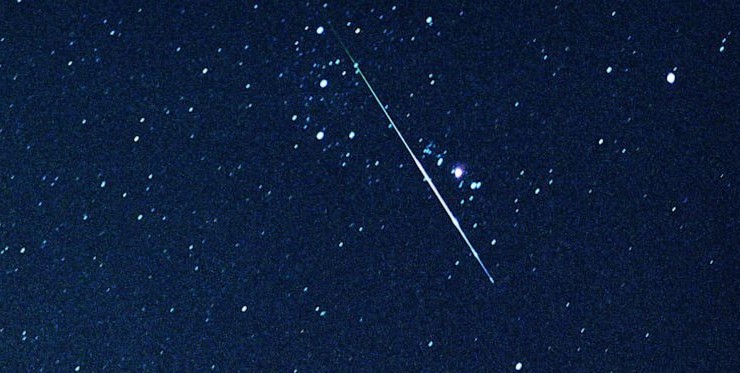There has been an Internet meme going around this year along the lines of “If 2020 were a _______, it would be ___________.” The answers are always bad. That has definitely NOT been the case for stargazing this year. As mentioned before in this space, 2020 has been one of the best years for watching the planets, with Venus on display as a brilliant “evening star” the first half of the year, and a fine “morning star” the second half. Mars is steadily brightening, now rising before midnight and on the way to what will be its best appearance for many years. Jupiter and Saturn are now visible in the southeast to south during the evening and converging for their Great Conjunction in December. Finally, Comet NEOWISE put on the best appearance for the northern hemisphere of any comet since Hale-Bopp in 1997.
Although NEOWISE has now faded from prominence, another comet-related spectacle will take center stage in August- the Perseid meteor shower. Each year, around mid-August, the Earth intersects with the orbit of Comet Swift-Tuttle, and debris left behind by the comet as it orbits the Sun burns up in Earth’s atmosphere. The Perseids are probably the best of the annual meteor showers, if you take into account both numbers seen and the comfort of observers watching them. At its peak, when seen in a moonless, non-hazy sky far from city lights, as many as one to two meteors per minute can be seen. Last year was an almost total washout, with the Full Moon lighting up the sky all night long. 2020 is better but not great, with the Last Quarter moon rising just after midnight, and in the east to south for the rest of the night. This half-lit Moon will certainly reduce the number of meteors seen between midnight and dawn but is not nearly as overpowering as it is when Full.
 A meteor blazing its way through the constellation Orion. Photo by the Sky Ranger.
A meteor blazing its way through the constellation Orion. Photo by the Sky Ranger.So, when to look? The Perseids appear to come from a point in the sky just south of the W-shaped constellation Cassiopea, which is low in the northeast early in the evening, gradually rising to almost overhead as dawn breaks. The largest number of meteors are generally seen between 1 or 2 in the morning and dawn, when the radiant point is high up- however this year, the Moon will be out then. This year, the night of August 11-12 is predicted to be the peak, but good numbers of meteors can be seen for a couple days on either side of this date. If you don’t want to stay up very late, try that evening from 11 pm- 1 am weather permitting, before the Moon interference becomes too strong. On the nights after the peak, the number of meteors will decline, but the Moon will rise later, presenting more of a window of opportunity.
I have seen the Perseids many times over the years and have found that the best way to see them is to lay out on a lawn chair, sleeping bag, or camping cot, and look high in the sky. Put the radiant point kind of at the edge of your line of sight, as the meteors will appear to move away from that spot in the sky. If the Moon has risen, try to look in a different direction or at least not directly at it, as it will ruin your adaptation to the dark sky. Other suggestions would be to use bug spray and perhaps bring a blanket, as the night air can become chilly and damp, even in the summer, if you are going to be outside for a long time. If at all possible, try to head for a location away from too many city lights, as light pollution will wipe out all of the fainter meteors. But if you can’t, try anyway. You might just see 5-10, maybe even 20 meteors, if you give it long enough. Meteor watching can be very relaxing- maybe bring along some coffee to stay awake! Let’s cross our fingers and hope for clear skies, both for this year and in 2021, when there will be no moon in the sky, creating ideal conditions.
Don’t miss our August 22 Gateway to the Stars program. Washington University scientist Jeffrey Gillis-Davis will offer a perspective on Apollo, and a virtual tour of the late summer night skies and video views of the Moon and planets will be presented. Check the Gateway Arch NPS Facebook page for details.
